 Laos Paper Money Collection
Laos Paper Money Collection Laos Paper Money Collection
Laos Paper Money Collection
| [ Last Update: Thursday, 12-Jan-2012 09:59:57 EST ] |
Kingdom of Lao, ພຣະຣາຊອານາຈັກລາວ (Phra Ratxa A-na-chak Lao) | |
| In the 19th century, Luang Prabang (in northern Lao) was incorporated into the 'Protectorate' of French Indochina, and shortly thereafter, the Kingdom of Champasak and the territory of Vientiane were also added to the protectorate. Under the French, Vientiane once again became the capital of a unified Lao state. Following a brief Japanese occupation during World War II, the country declared its independence in 1945, but the French under Charles de Gaulle re-asserted their control and only in 1950 was Laos granted semi-autonomy as an "associated state" within the French Union. Moreover, the French remained in de facto control until 1954, when Laos gained full independence as a constitutional monarchy. The 'Kingdom of Laos' was a sovereign state from 1953 until December 1975, when Communists overthrew the government and created the Lao People's Democratic Republic. Given self-rule in 1949 as part of a federation with the rest of French Indochina, the 1953 Franco-Lao Treaty finally established a sovereign, independent Laos, but did not stipulate who would rule the country. In the years that followed, three groups contended for power: the neutralists under Prince Souvanna Phouma, the right-wing party under Prince Boun Oum of Champassak, and the left-wing, Vietnamese-backed Lao Patriotic Front (now called the Pathet Lao) under Prince Souphanouvong and future Prime Minister Kaysone Phomvihane. On 5 May 1955, the Banque Nationale du Laos issued Kip ("Kip Vientiane") to replace the Indochinese piastre — Prior to 1957, see French Indo-China. | |
Banque Nationale Du Laos | |
1957 ND Issue - 1st Issue | |
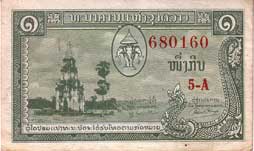 | P1 - 1b Kip, Second Issue (without planchets) Front: Tricephalic elephant arms at upper center, temple at left center Back: Farmer with water buffalo Size: 99 x 59 mm |
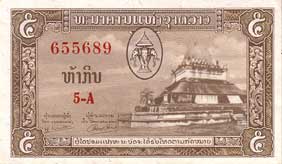 | P2b - 5 Kip, Second Issue (without planchets) Front: Tricephalic elephant arms at upper center, That Makmo at right center Back: Family with water buffalo cart Size: 110 x 64 mm On the south side of Phu Si hill, outside of the main area of the old city of Luang Prabang, is the very old temple of Wat Visoun, also called Wat Wisunalat. The temple's most notable feature is the large squat stupa in its forecourt. The stupa is properly know as That Pathum (Lotus Stupa) but is more commonly known as That Makmo because its shape resembles a watermelon ('makmo' being Lao for watermelon). |
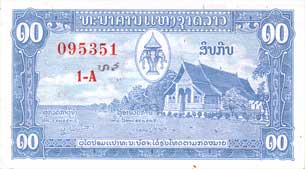 | P3 - 10 Kip, Second Issue (without planchets) Front: Tricephalic elephant arms at upper center, temple at right center Back: Workers planting rice Size: 119 x 65 mm |
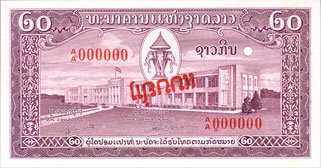 | P4s - 20 Kip Specimen Front: Government Palace, tricephalic elephant arms at upper center Back: Woman weaving Printer: Security Banknote Company, USA (not printed on banknote) Size: 125 x 65 mm |
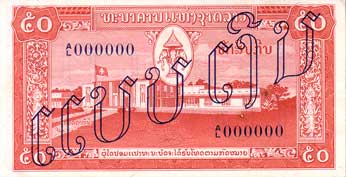 | P5s2 - 50 Kip, Second Issue (without planchets) Specimen Front: National Assembly Building, tricephalic elephant arms at upper center Back: Logger riding an elephant Size: 134 x 70 mm |
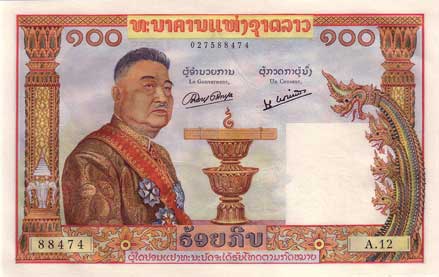 | P6 - 100 Kip Front: King Sisavang Vong at left center, fountain at center, nagas at right, tricephalic elephant arms at lower left Back: Temple and Lao girl with flowers Watermark: Tricephalic elephant arms Printer: Banque Du France (not printed on banknote) Size: 171 x 107 mm Sisavang Vong (or Sisavangvong) (14 July 1885 - 29 October 1959), was King of the Luang Phrabang and later Kingdom of Laos from 28 April 1904 until his death on 20 October 1959. |
1957 Commemorative Issue, 2500th Year of Buddhist Era | |
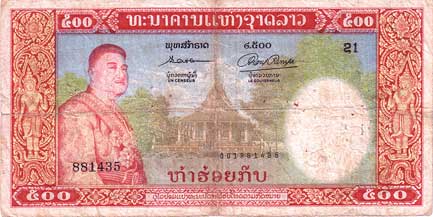 | P7a - 500 Kip Front: King Sisavang Vong at left center, building at center Back: That Luang Watermark: Tricephalic elephant arms Size: 169 x 85 mm |
1962 ND - 2nd Issue | |
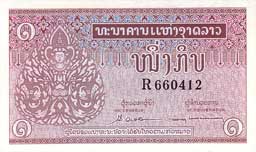 | P8 - 1 Kip Front: Stylized figure Back: Tricephalic elephant arms at center Size: 100 x 60 mm |
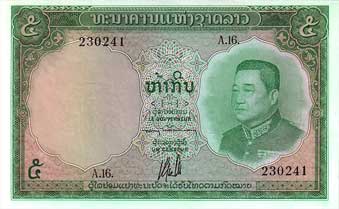 | P9 - 5 Kip Front: King Sisavang Vong Back: Temple, elephant with rider, and palm trees Size: 132 x 84 mm |
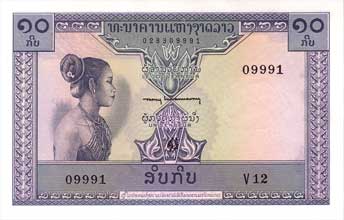 | P10 - 10 Kip Front: Woman at left Back: Stylized unburst similar to the front of the French Indochina 10 Piastres Note Watermark: Elephant head Size: 134 x 88 mm |
1963 ND - 3rd Issue | |
| In 1962. the government of King Savang Vatthana issued a 50 Kip note, popularly called "Khangkhai Kip" because the Government was established in Khangkhai District, Xiengkhoang Province. | |
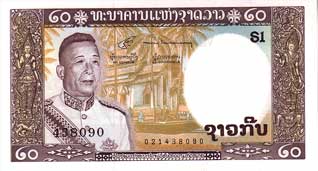 | P11 - 20 Kip Front: King Savang Vatthana at center right Back: Temple at center Watermark: Tricephalic elephant arms Size: 124 x 67 mm |
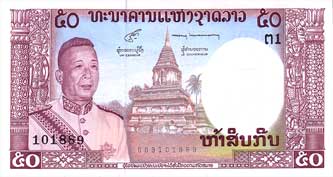 | P12 - 50 Kip Front: King Savang Vatthana at left, chedi at center Back: temple grounds Watermark: Tricephalic elephant arms Size: 134 x 68 mm |
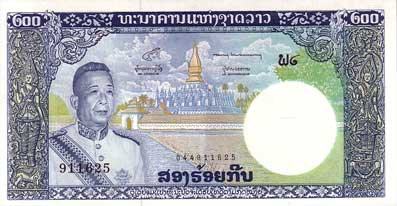 | P13b - 200 Kip Front: King Savang Vatthana at left, temple of That Luang at center Back: Waterfalls Watermark: Tricephalic elephant arms Size: 154 x 80 mm |
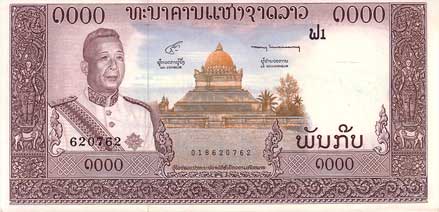 | P14b - 1000 Kip (1963) Front: King Savang Vatthana at left, temple at center Back: Three long canoes Watermark: Tricephalic elephant arms Size: 171 x 83 mm |
1974 ND - 4th Issue | |
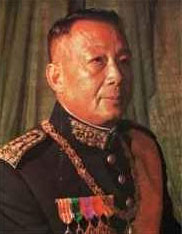 Savang or Sisavang Vatthana ruled from 1959 after his father's death, until his forced abdication in 1975. Savang Vatthana proved unable to manage a country in political turmoil. His rule ended with the takeover of the Pathet Lao in 1975, after which he and his family were sent to a re-education camp by the Pathet Lao. Savang or Sisavang Vatthana ruled from 1959 after his father's death, until his forced abdication in 1975. Savang Vatthana proved unable to manage a country in political turmoil. His rule ended with the takeover of the Pathet Lao in 1975, after which he and his family were sent to a re-education camp by the Pathet Lao. In 1968. the Pathet Lao government issued "Lao Liberation Kip" or "Pathet Lao Kip" notes in denominations of 10 kip, 20 kip, 50 kip, 100 kip, 200 kip and 500 kip to replace the "Khangkhai Kip" notes. | |
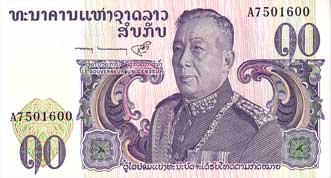 | P15 - 10 Kip Front: King Savang Vatthana at center right Back: Ox cart at center Watermark: Tricephalic elephant arms Size: 129 x 70 mm |
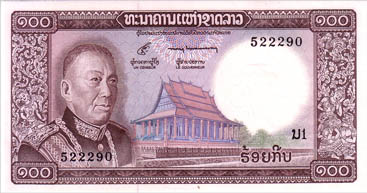 | P16 - 100 Kip Front: King Savang Vatthana at center right Back: Ox cart at center Watermark: Tricephalic elephant arms Size: 143 x 75 mm |
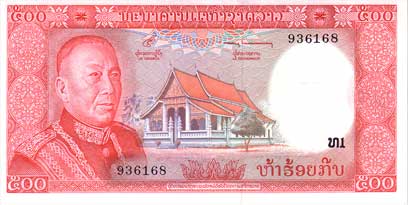 | P17 - 500 Kip Front: King Savang Vatthana at left Back: Hydroelectric dam Watermark: Tricephalic elephant arms Size: 164 x 82 mm |
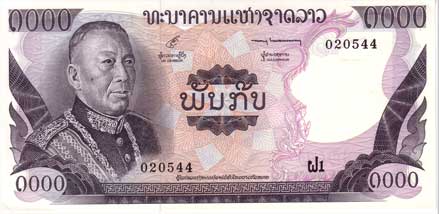 | P18 - 1000 Kip Front: King Savang Vatthana at left Back: Elephant in jungle at center right Watermark: Tricephalic elephant arms Size: 171 x 82 mm |
1975 ND - 5th Issue | |
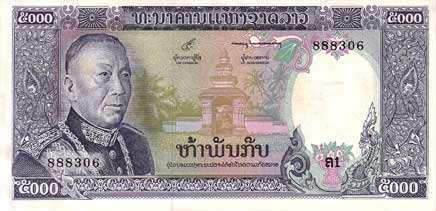 | P19 - 5000 Kip Front: King Savang Vatthana at left, pagoda at center Back: Musicians with traditional musical instruments at center Watermark: Tricephalic elephant arms Size: 170 x 83 mm |
Pathet Lao, ປະເທດລາວ (State of Lao) | |
| The Pathet Lao (Lao ປະເທດລາວ, "Lao State") was a communist political movement and organization in Laos, formed in the mid-20th century. The group was ultimately successful in assuming political power after a civil war, or insurgent revolution, lasting from the 1950s to 1975. The Pathet Lao were always closely associated with Vietnamese communists. During the civil war, it was effectively organized, equipped and even led by the army of North Vietnam. The Pathet Lao were the Laotian equivalent of the Viet Minh and the Viet Cong of Vietnam. Eventually, the term was the generic name for Laotian communists. The political movement of the Pathet Lao was called first the Lao People's Party (1955-1972) and later the Lao People's Revolutionary Party (1972-present). These notes were printed in the Peoples Republic of China and circulated in areas under control of Pathet Lao insurgents. After declaring Lao People's Democratic Republic on 02 December 1975, these "Lao Liberation Kip" notes became the accepted legal tender for the entire country replacing "Kip Kingdom of Lao (Kip Vientiane)" notes — 1 Lao Liberation Kip equals 20 "Kip Kingdom of Lao". | |
Pathet Lao Government | |
ND Issue | |
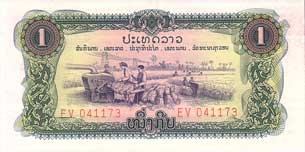 | P19A - 1 Kip Front: Thrashing grain at center Back: Medical examination scene Watermark: Repeating temples Size: 119 x 60 mm |
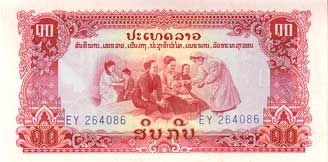 | P20a - 10 Kip Front: Medical examination scene Back: Fighers in the brush Watermark: Repeating temples Size: 128 x 64 mm |
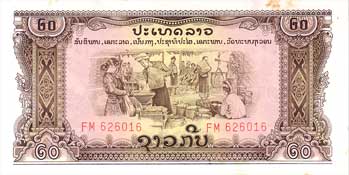 | P21a - 20 Kip Front: Rice distribution scene Back: Metal forge workers Watermark: Repeating temples Size: 136 x 64 mm |
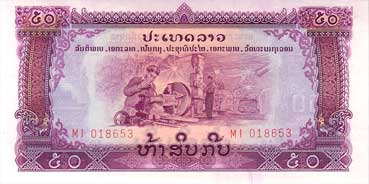 | P22b - 50 Kip Front: Metal works factory scene Back: Group of water buffalo and people Watermark: Repeating stars Size: 144 x 72 mm |
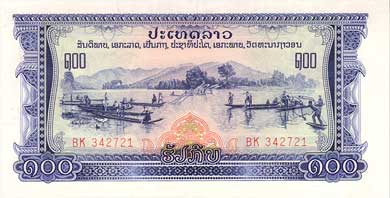 | P23 - 100 Kip Front: Long boats fishing on Mekong River Back: Textile shopping scene Watermark: Repeating temples Size: 151 x 76 mm |
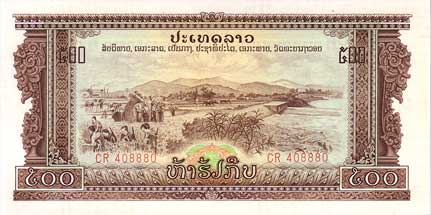 | P24 - 500 Kip Front: Armed field workers in farm scene Back: Soldiers shooting down planes Watermark: Repeating temples Size: 168 x 84 mm |
Lao People's Democratic Republic (Lao PDR) | |
| In 1975, the communist Pathet Lao, along with Vietnam People's Army and backed by the Soviet Union, overthrew the royalist Lao government, forcing King Savang Vatthana to abdicate on 2 December 1975. He later died in captivity. After taking control of the country, Pathet Lao's government renamed the country as the "Lao People's Democratic Republic" The currency reform of 16 December 1979, replaced the Lao Liberation Kip with a new National Bank Kip — 1 new National Bank Kip equals 100 Lao Liberation Kip. | |
Bank of the Lao PDR | |
1979 ND Issue - 1st Issue | |
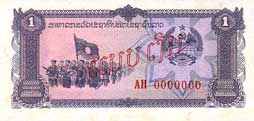 | P25s - 1 Kip Specimen Note Front: Militia unit at left, Arms at upper right Back: Schoolroom scene at left Watermark: Stars, hammer, and sickles Size: 99 x 48 mm |
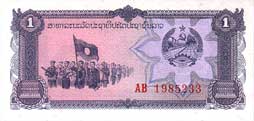 | P25 - 1 Kip Serial Number: AB1985233 Front: Militia unit at left, Arms at upper right Back: Schoolroom scene at left Watermark: Stars, hammer, and sickles Size: 99 x 48 mm |
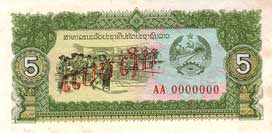 | P26s - 5 Kip Specimen Note Front: Shoppers in a store at left, Arms at upper right Back: Logging elephants at left Watermark: Stars, hammer, and sickles Size: 106 x 52 mm |
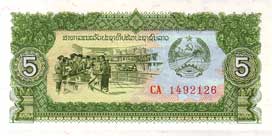 | P26 - 5 Kip Serial Number: CA1492126 Front: Shoppers in a store at left, Arms at upper right Back: Logging elephants at left Watermark: Stars, hammer, and sickles Size: 106 x 52 mm |
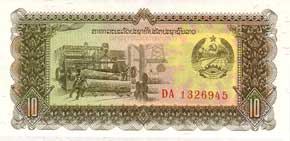 | P27 - 10 Kip Front: Lumber mill at left, Arms at upper right Back: Medical scenes at left Watermark: Stars, hammer, and sickles Size: 113 x 56 mm |
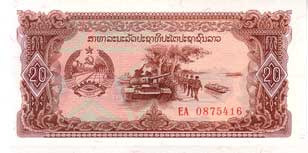 | P28 - 20 Kip Front: Arms at left, tank with troop column at center Back: Textile mill at center Watermark: Stars, hammer, and sickles Size: 120 x 60 mm |
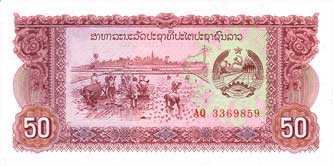 | P29 - 50 Kip Serial Number: 3369859 Front: Arms at right, planting rice at center left Back: Hydroelectric dam at center Watermark: Stars, hammer, and sickles Size: 130 x 64 mm |
1986 ND Issue - 2nd Issue | |
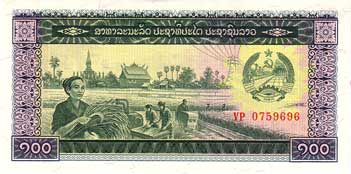 | P30 - 100 Kip Front: Grain harvesting at right center, arms at upper right Back: Storage tank and soldier at center Watermark: Stars, hammer, and sickles Size: 137 x 68 mm |
1988 Issue - 3rd Issue | |
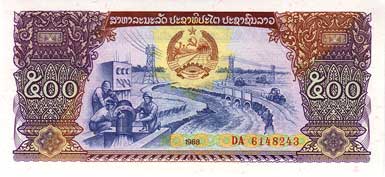 | P31 - 500 Kip Front: Modern irrigation systems at center, arms above Back: Harvesting fruit at center Watermark: Stars, hammer, and sickles Size: 150 x 69 mm |
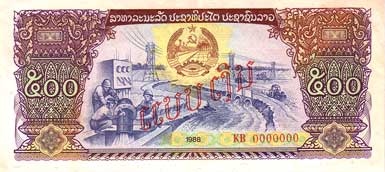 | P31s - 500 Kip Specimen Note Front: Modern irrigation systems at center, arms above Back: Harvesting fruit at center Watermark: Stars, hammer, and sickles Size: 150 x 69 mm |
1992-1996 Issue - 4th Issue | |
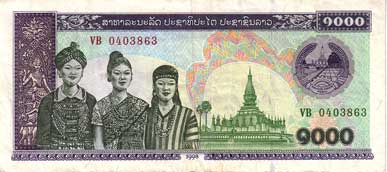 | P32Aa - 1998 1000 Kip Front: Three women at left, Temple at center, arms at upper right Back: Cattle at center Watermark: Stars Size: 151 x 68 mm |
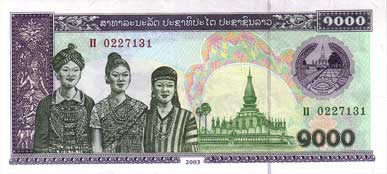 | P32Ab - 2003 1000 Kip Replacement Note — The "II" Prefix indicates a replacement note 220,000 replacement notes issued Front: Three women at left, Temple at center, arms at upper right Back: Cattle at center Watermark: Stars Size: 151 x 68 mm |
1997 Issue - 5th Issue | |
 Kaysone Phomvihane was the leader of the Lao People's Revolutionary Party from 1955. He served as the first Prime Minister of the Lao People's Democratic Republic from 1975 to 1991 and then as President from 1991 until his death in 1992. Kaysone Phomvihane was the leader of the Lao People's Revolutionary Party from 1955. He served as the first Prime Minister of the Lao People's Democratic Republic from 1975 to 1991 and then as President from 1991 until his death in 1992. | |
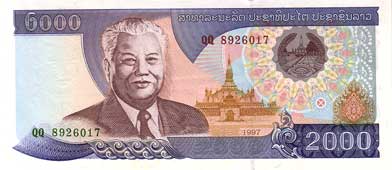 | P33a - 2000 Kip, 1997 Front: Kaysone Phomuihane at left, Pha That Luang at center, arms at upper right Back: Hydroelectric complex at center Watermark: Kaysone Phomuihane UV: Fluorescent green arms at upper right on front, blue and red fluorescent fibers, fluorescent yellow "ສບບລາວ" ("SPP Lao" for "Sathalanalat Paxathipatai Paxaxon Lao", the Lao Peoples Democratic Republic) on back to the left of the hydroelectric complex Size: 153 x 68 mm |
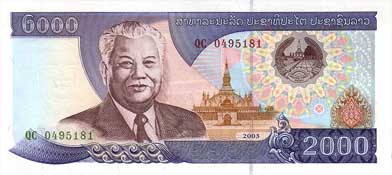 | P33b - 2000 Kip, 2003 Front: Kaysone Phomuihane at left, Pha That Luang at center, arms at upper right Back: Hydroelectric complex at center Watermark: Kaysone Phomuihane UV: Fluorescent green arms at upper right on front, blue and red fluorescent fibers, fluorescent yellow "ສບບລາວ" ("SPP Lao" for "Sathalanalat Paxathipatai Paxaxon Lao", the Lao Peoples Democratic Republic) on back to the left of the hydroelectric complex Size: 153 x 68 mm |
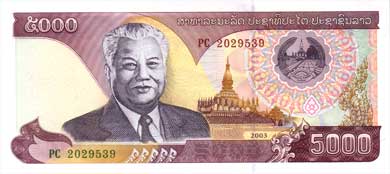 | P34b - 5000 Kip, 2003 Front: Kaysone Phomuihane at left, Pha That Luang at center, arms at upper right Back: Cement factory complex at center Watermark: Pha That Luang UV: Fluorescent yellow arms at upper right on front, blue and red fluorescent fibers, fluorescent yellow "ສບບລາວ" ("SPP Lao" for "Sathalanalat Paxathipatai Paxaxon Lao", the Lao Peoples Democratic Republic) on back to the left of the hydroelectric complex Size: 152 x 68 mm |
2002 Issue - 6th Issue | |
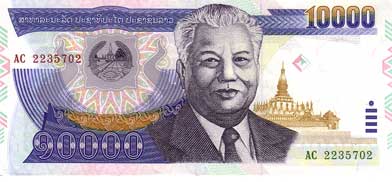 | P35a - 10000 Kip, 2002 Front: Kaysone Phomuihane at left, Temple at center Back: Bridge over Mekong river at center Watermark: Kaysone Phomuihane Size: 153 x 68 mm |
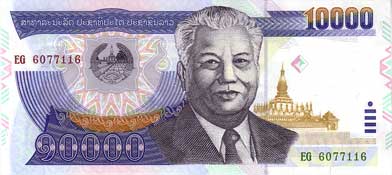 | P35b - 10000 Kip, 2003 Front: Kaysone Phomuihane at left, Temple at center Back: Bridge over Mekong river at center Watermark: Kaysone Phomuihane Size: 153 x 68 mm |
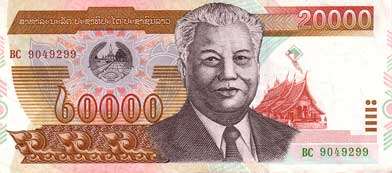 | P36a - 20000 Kip, 2002 Front: Kaysone Phomuihane at left, Temple at center Back: Theun-Hinboune Hydroelectric complex at center Watermark: Kaysone Phomuihane Size: 153 x 68 mm |
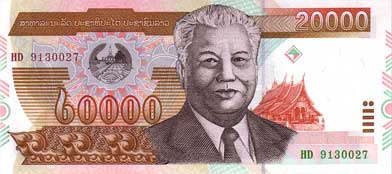 | P36b - 20000 Kip, 2002 Front: Kaysone Phomuihane at left, Temple at center Back: Theun-Hinboune Hydroelectric complex at center Watermark: Kaysone Phomuihane Size: 153 x 68 mm |
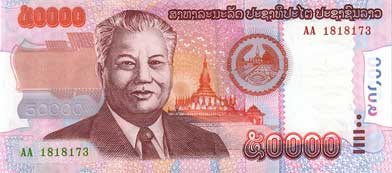 | P37 - 50000 Kip, 2004 Front: Kaysone Phomuihane at left, Temple at center Back: Building at left center Watermark: Kaysone Phomuihane Size: 153 x 68 mm |
2008 ND Issue | |
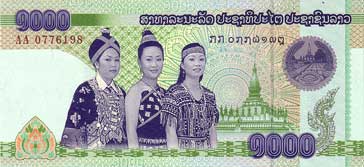 | PNEW - 1000 Kip Front: Three young women in traditional dress at center, Pha That Luang, the national symbol of Laos in Vietiane and coat of arms at center right Back: Traditional Lao dancer at center left, elephant below, grazing cattle and power lines at center Watermark: Pha That Luang Size: 142 x66 mm The note was released on October 31, 2008, but the Bank of the Lao PDR began withdrawing the note in November 2008. A bank representative stated only that it was done at "the government's discretion," because the note depicts three actual people based upon photographs, not an artist's rendering of representative women.
|
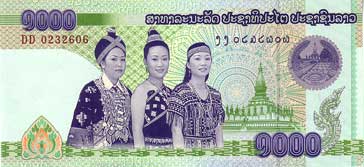 | PNEW - 1000 Kip Replacement Note — The "DD" Prefix indicates a replacement note Front: Three young women in traditional dress at center, Pha That Luang, the national symbol of Laos in Vietiane and coat of arms at center right Back: Traditional Lao dancer at center left, elephant below, grazing cattle and power lines at center Watermark: Pha That Luang Size: 142 x66 mm The note was released on October 31, 2008, but the Bank of the Lao PDR began withdrawing the note in November 2008. A bank representative stated only that it was done at "the government's discretion," because the note depicts three actual people based upon photographs, not an artist's rendering of representative women.
|
2010 Issue | |
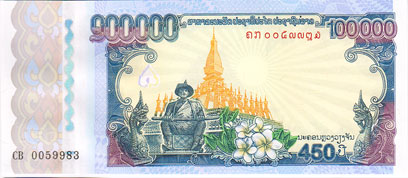 | PNEW - 100000 Kip Issue Date: 15 November 2010 Serial Number: CB 0059983 Front: Pha That Luang, Statue of Seated King Setthathirat in Grounds of Pha That Luang, Vientiane, 450 at lower right indicating the 450th anniversary of Vientiane as the nations' capital Back: Ho Phra Keo temple in Vientiane The Bank of the Lao PDR printed 1,500,000 new banknotes to mark the 450th anniversary of Vientiane as the nation's capital and the 35th anniversary of the establishment of the Lao PDR. |
2011 Issue | |
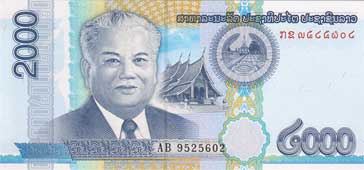 | PNEW - 2000 Kip, 2011 Front: Kaysone Phomuihane at left, temple at center, arms at upper right Back: Hydroelectric complex at center Watermark: Kaysone Phomuihane UV: Fluorescent green arms at upper right on front, fluorescent seal beneath, fluorescent strip with denomination at left, blue and green fluorescent fibers, fluorescent yellow denomination on back to the left of the hydroelectric complex Size: 142 x 66 mm |